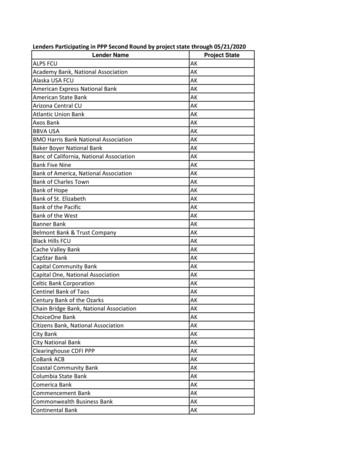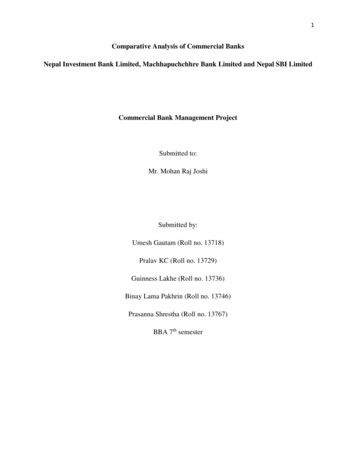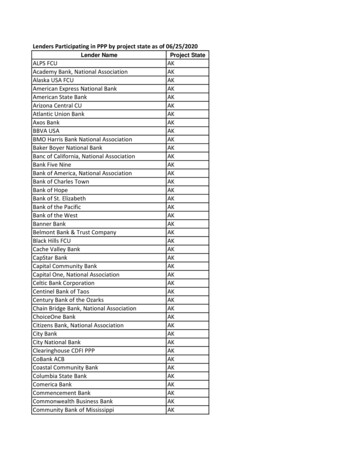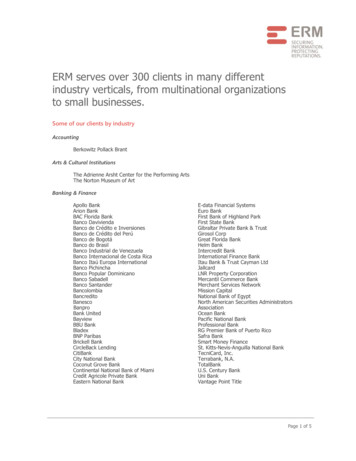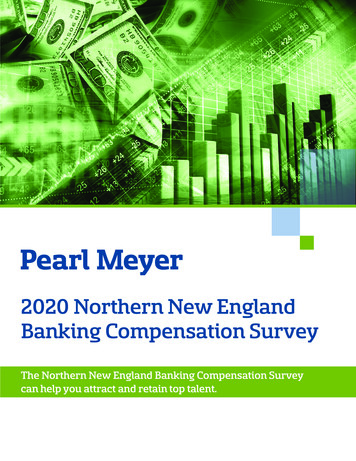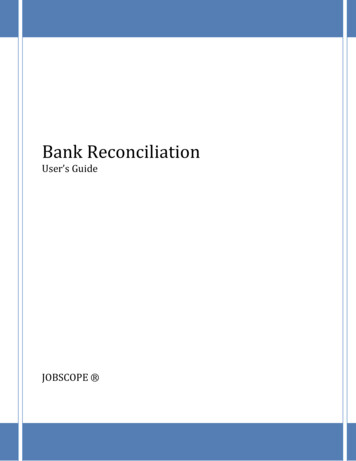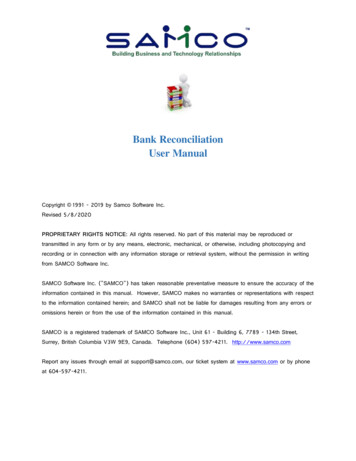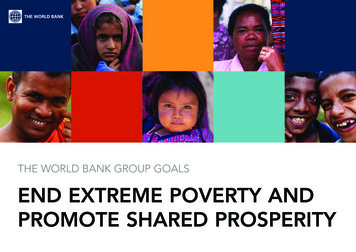
Transcription
THE WORLD BANK GROUP GOALSEND EXTREME POVERTY ANDPROMOTE SHARED PROSPERITY
CONTENTThe World Bank Group Mission, Goals, and IndicatorsEnding Extreme PovertyEnding poverty within a generation—difficult, but achievablePromoting Shared ProsperityAn indicator of growth with equity and inclusionShared prosperity and inequalityPathways to shared prosperity and poverty reductionSustainability managing our planet for future generations fostering an inclusive society and ensuring fiscal sustainability510121820222529303334Figure / BoxFigure 1: Regional changes in the population of extreme poor over the yearsFigure 2: Poverty has fallen steadily since the 1980s except in Africa where the decline began laterBox 1: Destitution could continue after 2030 in some of the poorest countriesFigure B1: Poverty in selected low-income countriesFigure 3: Inequality tends to be lower in high-income countriesFigure 4: Shared Prosperity Indicator in selected countries (circa 2000-10)Figure 5: Labor market factors contributed the most to poverty reduction, selected countries13141616222426
THE WORLD BANK GROUPMISSION, GOALS, AND INDICATORS5Photo: Curt Carnemark
Although poverty has declined rapidlyover the past three decades, humanitystill faces urgent and complex challenges. More than 1 billion people worldwidestill live in destitution, a state of affairsthat is morally unacceptable given theresources and the technology availabletoday. Moreover, rising inequality andsocial exclusion seem to accompany therising prosperity in many countries. Under these circumstances, the World BankGroup’s overarching mission of a worldfree of poverty is as relevant today as ithas ever been.6Photo: Arne HoelThe World Bank Group has establishedambitious but achievable goals to anchor its overarching mission and togalvanize international and nationalefforts in this endeavor. Accordingly, theinstitution will strive to (i) end extremepoverty at the global level within a generation and (ii) promote what may becalled “shared prosperity”: a sustainableincrease in the well-being of the poorersegments of society. This second goalreflects the fact that all countries aspireto rapid and sustained increases in livingstandards for all of their citizens, not justthe already privileged. These two goalsand their respective indicators can besummarized as:
End extreme poverty:the percentage of people living with less than 1.25 aday to fall to no more than 3 percent globally by 2030;Promote shared prosperity:foster income growth of the bottom 40 percent of thepopulation in every country.Ending extreme poverty within a generation and promoting shared prosperity must be achieved insuch a way as to be sustainable over time and acrossgenerations. This requires promoting environmental,social, and fiscal sustainability. We need to securethe long-term future of our planet and its resourcesso future generations do not find themselves in a wasteland. We also must aim for sustained social inclusion and limit the size of economic debtinherited by f uture generations.7
We are aware that these two monetary indicators do not adequately accommodateall the dimensions of poverty that represent our mission. But to insert every dimension explicitly into a limited number of measures is to risk creating such complexindicators that they will be ill-understood. Each of the monetary indicators we haveadopted has the advantage of capturing the key elements of welfare in a single,compelling measure. While these monetary measures will define our goals, we willcontinue to maintain a strong focus on multiple dimensions of welfare.Ending poverty and promoting shared prosperity areunequivocally also about progress in non-monetarydimensions of welfare including education, health,nutrition, and access to essential infrastructure, aswell as about enhancing voice and participation of all segments of society in economic, social, and politicalspheres.Photo: Simone D. McCourtie8
The goals we have articulated are notsolely for the World Bank Group toachieve but rather are goals that wehope are consistent with those of our188 member countries. The goals willguide the World Bank Group’s strategyas we continue our transformation intoa “Solutions Bank” by influencing whatthe organization does and how, and byhelping it become more selective andfocused in its activities. The goals arewell-aligned with the overall objectivesof the Millennium Development Goals(MDGs) process and reiterate our unwavering commitment to support it and tohelping shape the Post-2015 Agenda.Photo: Visual News Associates9
ENDING EXTREME POVERTY10Photo: Curt Carnemark
Ending extreme poverty is a moral imperative andarguably one of the most compelling challengesfacing the development community. We are settinga target date for reaching an extreme povertyrate of no more than 3 percent in 2030, using theinternationally established measure of theproportion of people living on less than 1.25 a day.While representing a very frugal threshold, the 1.25 standard is well-accepted inthe development community as one of the Millennium Development Goals, and itwould allow the World Bank Group to focus its central mission in measurable, intuitive, and transparent terms.Reaching the target, which would effectively end extreme poverty globally in lessthan a generation, is an ambitious endeavor. It will require sustaining high rates ofeconomic growth across the developing world, as well as translating growth moreeffectively into poverty reduction in each developing country. Reaching the targetalso requires governance, institutional, and social policy changes not seen yet inmany poor countries, and hence enormous efforts from national governments andthe international community.11
Ending poverty within a generation—difficult, but achievableReducing the global extreme povertyrate to no more than 3 percent in 2030is not a prediction. It is a target that weconsider difficult but achievable, givenrecent experience. It will require a fall inpoverty by about one percentage pointper year during this period, which isabout the same as the average annualreduction seen since 1980. It impliesmaintaining a growth rate of per capitahousehold income in the developingworld at least as high as that achievedsince 1999.At the same time, maintaining such agrowth rate will be far from business asusual. That trajectory is a highly optimistic scenario, as it assumes continuingthe pattern of strong growth in the developing world, successfully managingany global shock to limit its impact on12the poor, and preventing inequality fromincreasing. Also, a one percentage pointreduction in extreme poverty per yearbecomes progressively harder to achieveas the rate declines, because each successive one percentage point representsan increasingly larger share of the overallpoverty rate. One might thus expect thepace of global poverty reduction to slowdown in the coming years relative to theReducing the global extremepoverty rate to no more than3 percent in 2030 is not a prediction. It is a target that weconsider difficult but achievable,given recent experience.trend in previous decades. Transformingthe trajectory to maintain the historical trend in effect requires bending the“natural arc” of history.The ambition of the target can also beseen in other respects. China accountedfor more than half of the total reduction in global poverty between 1980and 2000, but China’s overall contribution would precipitously decline as itcomes closer to ending extreme poverty.Recent history shows this trend starkly(Figure 1). Between 1981 and 2010, whenthe number of extreme poor in the worlddropped, the proportion of the poor inEast Asia and Pacific (including China)fell from around 57 percent to 20 percent as the number of poor in the regiondeclined dramatically.
Figure 1: Regional changes in the population of extreme poor over the ,6001,8002,000millionsEast Asia and Pacific (including China)South Asia (including India)Sub-Saharan AfricaOther regionsTo reach the global targetfor 2030, the pace ofpoverty reduction in SubSaharan Africa and SouthAsia will assume increasing importance. For SubSaharan Africa, where twodecades of disappointment have been followedby a decade of unprecedented poverty reductionduring the 2000s (Figure2), a further accelerationof this trend is needed.Note: Other regions are Europe and Central Asia, Middle East and North Africa, and Latin America and the Caribbean.Source: World Bank database, based on country household surveys.13
In 12 countries in Sub-SaharanAfrica, the extreme povertyrate is above 60 percent; in four cases it is above 80 percent.Reaching the global target of 3 percentin 2030 will require rapid economicgrowth in low-income coun tries, whichin turn must be translated into a rateof poverty reduction that is higher andsustained over longer pe riods than everseen in the past. This will not be possible without long-term structural changesin many low-income countries.Figure 2: Poverty has fallen steadily since the 1980s except in Africa where the decline began laterPopulation living on less than 1.25 a day, 2005 PPP (%)The extent of the challenge in lowincome countries, many of which arein Sub-Saharan Africa, is illustrated bythe high rates of current extreme poverty. More than one-third of countriesin Sub-Saharan Africa, several of themfragile and conflict-affected states, hadan extreme poverty rate of more than50 percent in 2010. In 12 countries inSub-Saharan Africa, the extreme povertyrate is above 60 percent; in four cases(Burundi, the Democratic Republic ofCongo, Liberia, and Madagascar), it isabove 80 percent.706050403020Sub-Saharan AfricaDeveloping 520082010** Preliminary** World Bank staff calculations assuming extreme poverty in high-income countries to be near-zero.Source: World Bank database, based on household surveys from countries.14* Preliminary
Increasing the welfare of the poor in low-incomecountries will require complex institutional and governance reforms that enhance the accountabilityof the state, raise the quality of service delivery, and improve the overall economic and social environment.An additional challenge will be to contain rises in inequality within countries. Ifinequality were to continue rising, as it has recently in some large middle-incomecountries, achieving the global target would require even higher overall growthrates. The feasibility of eliminating extreme poverty will also depend on the occurrence of and ability to manage large-scale economic shocks—like food, fuel, orfinancial crises—as well as natural and climate change-related disasters. All of theseevents pose significant risks to the pace and sustainability of poverty reduction.At the same time, however, some of these challenges may be balanced by thepromise of technological breakthroughs, which could result in rapid rises in productivity and open up new opportunities for economic transformation and betterdesigned social policies. Such breakthroughs are already being embraced and aretransforming the poverty-reduction path in some countries.Photo: John Hogg15
Box 1: Destitution could continue after 2030in some of the poorest countriesWe envisage the fight against extremepoverty to by and large come to anend as a global endeavor by 2030. Buteven as the global extreme poverty ratereaches 3 percent, much higher rates are100908070605040Developing worldaverage in 2010*(21%)3020100Nepal 2010Timor-Leste 2007Sierra Leone 2003Haiti 2001Tanzania 2007Zambia 2006Madagascar 2010Burundi 2006Liberia 2007Congo, Dem. Rep.2005Population living on less than 1.25 a day, 2005 PPP (%)Figure B1: Poverty in selected low-income countries* Preliminary*PreliminarySource: World Bank database, based on household surveys from countries.16likely still to exist in some of the poorestcountries or Fragile and Conflict-Affected Situations (FCS). The fight againstextreme poverty, at the level of eachindividual country, would not necessarily come to an end everywhere. Manyof these countries are characterized bysevere institutional and policy challengesthat will likely endure in the medium tolonger term. The fight against poverty inits current form thus may need to continue well beyond a generation, until largescale deprivation ends not only on average among the global population, but ineach individual country, large and small.We will work with such countries to define ambitious country-specific paths ofpoverty reduction consistent with eachcountry’s economic, social, and institutional challenges.
The world already has the economic andtechnological resources to achieve thetarget of ending extreme poverty globally in a generation. We hope the targetwill act as a catalyst for the aspirations ofnational governments and for accelerated and coordinated efforts in the globaldevelopment community.Photo: Curt Carnemark17
PROMOTING SHARED PROSPERITY18Photo: Dana Smillie
The World Bank Group’s mission of aworld free of poverty involves a continuing commitment to increasing thewelfare of the poor and vulnerable inevery country. Ending extreme povertywherever it exists is a priority. However,our mission is not just about the poorest developing countries, but aboutpoor people everywhere. Judged by thestandards of each society, significant levels of poverty remain in most developing countries and must be addressed ifsocieties are to achieve the stability andwell-being to which they aspire.Raising the incomes of the poor in every country means ensuring that rising prosperity benefits the less well-off.The World Bank Group and the development community as a whole have aresponsibility toward them. While sharedprosperity requires the pursuit of rapidand sustained expansion of the economy, any type of growth will not suffice.What is needed is sustainable growththat achieves the maximum possibleincrease in living standards of the lesswell-off.Our mission is not just aboutthe poorest developing countries, but about poorpeople everywhere.19
An indicator of growth with equity and inclusionWe will monitor progress in shared prosperity using the income growth of the bottom 40 percent of a nation’s population. This implies a direct focus on the income ofthe less well-off, as opposed to the common practice of focusing only on growth ofGDP per capita and implicitly relying on the “trickle down” impact of growth on thebottom of the distribution.Our shared prosperity indicatorimplies a direct focus on the income of the less well-off,The measure captures the two elements central to the notion of shared prosperity: as opposed to the commona growing economy and a fundamental concern for equity. Sustained growth is nec- practice of focusing only onessary; without it, the less well-off are unlikely to increase their living standards in the growth of GDP per capita andin the medium to long run. But improvement in the indicator requires growth to beimplicitly relying on the “trickleinclusive, which in turn calls for a social contract within each country demanding thatdown” impact of growth on thethe poor be a priority in the policy environment that supports the growth process.1bottom of the distribution.Our indicator of shared prosperity is also consistent with the idea of prosperitybeing “unbounded,” as opposed to being defined by an absolute standard thateveryone should reach, which means that a global target is not relevant.120A cut-off at 40 percent to define this bottom segment is admittedly arbitrary, but all cut-offs have some arbitrariness. Development economists have used “the bottom quintile” to refer to the group whoshould receive more attention from policy makers. But in many low-income countries this is close to the percentage of people of in extreme poverty, and therefore covered by the extreme poverty indicator. We choose a percentage that currently roughly coincides with the proportion of the population that is considered moderately poor in middle-income countries.
Shared prosperity, understood in thisway, is not an agenda of redistributingan economic pie of a fixed size.Rather, it means expanding the sizeof the pie continuously and sharingit in such a way that the welfare ofthose at the lower end of the income distribution rises as quickly as possible.It also requires that progress is sustainable over time and across generations,in terms of the environment, social inclusion, and fiscal prudence.Photo: Jerome Ascano21
Shared prosperity and inequalityIncome growth of the bottom 40 percentin a country could occur, at least temporarily and especially in low-income countries, at the expense of rising inequality,implying average income growing fasterthan the income of the poor. Some risein inequality could well be necessary togenerate growth, by creating incentivesthat reward innovation and risk takingand inducing firms and people to investin human and physical capital. For example, this occurred in some East Asiancountries a few decades ago, whenincome growth of the bottom 40 percent was strong but lagging behind thegrowth of average income.Figure 3: Inequality tends to be lower in high-income countries65Inequality (Gini 0,000GDP Per capita, US (2005 PPP)Source: World Bank database, based on household surveys from countries.2250,000But in many cases growth in the incomesof the poor will be accompanied by falling inequality, as has been witnessed inmany Latin American countries duringthe past decade. Moreover, sustainedprogress in shared prosperity is incompatible with a long-term increase ininequality.
Growth of the bottom40 percent that is consistently lower thanthe average incomegrowth should be acause for concern. This is because the associatedrise in inequality couldeventually stifle thegrowth process itselfby affecting the qualityof institutions, causing political instability, andreducing mobility in society.23Recent research at the InternationalMonetary Fund, for example, suggeststhat high inequality is associated withshorter growth episodes;2 and otherempirical research has identified highstructural inequality to be an obstacle toeconomic development.3 In general, nocountry has transited beyond middleincome status while maintaining highlevels of inequality (Figure 3). Most likely,then, where inequality is high, boostingshared prosperity will require that theincome of the bottom 40 percent growsfaster than the average income of thepopulation.What is good performance in sharedprosperity? The higher the growth of theincomes of the poor, the better it is. Butwhat a country can strive for depends onNo country has transited beyond middle-income statuswhile maintaining high levels ofinequality.a number of factors, including the initialincome distribution and level of development, as well as the overall growth rate.The past decade provides mixed newson income growth of the bottom segment in each country (Figure 4). In thepast decade, in 20 out of 55 developingcountries, real per capita incomes (orconsumption) of the bottom 40 percentgrew at a healthy average rate of morethan 5 percent annually.“What makes growth sustained?” by A. Berg, J. Ostry and J. Zettelmeyer (2012), Journal of Development Economics, 98(2).“Inequality does cause underdevelopment: Insights from a new instrument” by W. Easterly (2007), Journal of Development Economics, 84(2).23
In the last decade, in 60 percent of developing countries,including large countries likeBrazil and Mexico, incomes ofthe bottom 40 percent actuallygrew faster than the averageof the population, which meansthat there was a fall in inequality.But in other countries, such as Egypt,income growth of the bottom 40 percentwas close to zero. Even though inequality was also falling, it is hard to say thatthere was shared prosperity in thesecountries. By focusing on the incomegrowth of the bottom 40 percent byitself, rather than on this rate relative tothe average rate of income growth, weensure that welfare improvement amongthe less well-off in every country is ourprimary concern.Figure 4: Shared Prosperity Indicator in selected countries (circa 2000-10)14Consumption growth of the bottom 40% (%)Figure 4 also illustrates two additionalpoints. First, there is a strong and positive association between income growthof the bottom 40 percent and growthin average income. Second, in the lastdecade, in 60 percent of developingcountries, including large countries likeBrazil and Mexico, incomes of the bottom 40 percent actually grew faster thanthe average of the population, whichmeans that there was a fall in inequality.12Consumption growth of thebottom 40% is positive andfaster than the rate of theentire domestic economy.10Russian Federation86BrazilChinaMexicoSouth AfricaIndonesia4Rwanda2BangladeshConsumption growth of thebottom 40% is positive andslower than the rate of theentire domestic economy.Egypt, Arab Rep.0-4-2Côte d'Ivoire0246810-2-4Consumption growth of the total population (%)Source: World Bank database, based on household surveys from countries.241214
Pathways to shared prosperity and poverty reductionThe goals of ending extreme povertyand promoting shared prosperity highlight the need for social, economic, andinstitutional arrangements that fosterwelfare and income growth of the lesswell-off. Growth that includes the poorand accelerates progress toward a justsociety does not come automatically.It requires mechanisms to ensure thatthe less well-off not only enjoy the benefits of that growth process but are alsointegral to the process. How a specificsociety chooses to provide these opportunities will be context- and time-dependent, with no single optimal institutionalarrangement applicable to all societies.Prosperity can be broad-based if growthgenerates jobs and economic opportunities for all segments of the population.This requires pursuing an agenda ofphysical and human capital accumulation, competitiveness, and innovation.The most effective path out of povertyis through access to more and betterjobs, through rapid and broad-basedgrowth centering on the strong contribution by the private sector. Jobs not onlyincrease the earnings of the poor but arealso transformative because efficiencyincreases as workers get better at whatthey do and as more productive jobsreplace less productive ones.Prosperity can be broad-basedif growth generates jobs andeconomic opportunities for allsegments of the population.In the decade of the 2000s, most of thereduction in poverty in successful countries across the globe was related tobetter labor market engagement in theform of more and better-paying jobs.Direct income transfers to the poor, remittances, and changes in demographicpatterns contributed much less (see Figure 5 for a few country examples).25
The government has a key role in creating the overall environment foreconomic growth and shared prosperity, including by improving competitiveness, promoting a favorable investmentclimate, and encouraging innovation.The state also has the critical responsibility for investing in people so thatthey can be part of a modern and dynamic workforce.426Figure 5: Labor market factors contributed the most to poverty reduction, selected countries(decade of the 2000s)4Annual poverty reduction (percentage points)Evidence also suggeststhat poverty reductionis higher when growthis biased toward labor- intensive sectors4, andwhen growth is diversi fied and generates employment opportunitiesacross multiple sectors.32Non-labor income1Labor incomeDemographic 2000-09)Source: J. Azevedo, G. Inchauste, S. Olivieri, J. Saavedra and H. Winkler (2013). “Is labor incomeresponsible for poverty reduction? A decomposition approach”, (April, forthcoming as World BankPolicy Research Working Paper).“The composition of growth matters for poverty alleviation,” by N. Loayza and C. Raddatz (2010), Journal of Development Economics, 93(1).
A healthy and stable social contractis needed to ensure that growth includes the poorer segments of society. This requires investmentsthat improve opportunities forall citizens, including women andyouth, and that provide safety netsto protect the vulnerable against extreme deprivation and shocks.The social contract would also include adequate mechanisms to raise resources to support these policies,including a tax system that createsincentives for economic growth andpromotes fairness.Photo: Maria Fleischmann27
The redistribution of resources impliedin a social contract is not just a matter oftransferring income from one segmentof the society to another at one point oftime, but is also an investment in people,to promote growth and equity over timeand across generations.The social contract for promoting equityand growth should aim to create an “opportunity society,” where the human andproductive potential of every individual,regardless of gender, region, ethnicity,or parental background, is maximized.In childhood and youth, this would implyproviding universal access to early childhood development, health, nutrition, education, and basic infrastructure to buildhuman capital and increase long termproductivity. For a society as a whole, this28will enhance mobility on the economicand social ladder within and across generations. For the World Bank Group, itimplies a continued multisectoral agendawith a particular lens—one that has, as apriority, the welfare of the less well-off.An important part of the social contractwould be to create conditions that enable women to contribute to their fullestpotential in the development process,by dismantling barriers to their participation in the economic, social, and political spheres in many societies. Genderequality is not just a core developmentobjective; it also enhances productivity,improves development outcomes for thenext generation, and makes institutionsmore representative.The social contract for promoting equity and growthshould aim to create an “opportunity society,” wherethe human and productive potential of every individual, regardless of gender, region,ethnicity, or parental background, is maximized.
SUSTAINABILITYPhoto: Arne 29Hoel
managing our planet for future generationsSustainability is an overarching themethat frames both goals of the WorldBank Group. These goals must beachieved in an environmentally, so cially,and fiscally sustainable manner. A sustainable path of development andpoverty reduction would be one that: (i)manages the resources of our planet forfuture generations, (ii) ensures social inclusion, and (iii) adopts fiscally responsible policies that limit future debt burden.Economic growth, which is critical tocontinuing the process of poverty reduction, has to be compatible with thelimits imposed by the resources of theplanet. The past two decades have seena significant toll on the environment. Forexample, an estimated 5.2 million hectares of forest were lost annually between2000 and 2010. More than 550 billiontons of CO² have been emitted globally between 2000 and 2010—leading toincreased global temperatures and morefrequent and intense floods, droughts,and storm surges. Air pollution is a majorproblem in almost all megacities of thedeveloping world, and 87 percent of theworld’s ocean fisheries are over-exploited or depleted.Continuing along such a path will threaten the long-term future of theplanet and its resources, and, of course,30the process of economic growth andpoverty reduction itself. There are signsof this happening already. Unsustainablemanagement of ecosystems has disproportionate impact on the poor, sincethe poor are often more dependent onecosystems and the goods and servicesthey provide. Poor people are alwaysthe least able to protect their childrenfrom the harmful impacts of pollutionon health and educational outcomes,the accumulated impacts of which reduce earnings and quality of life acrossgenerations. Water and land constraintsare already affecting poverty. Some 28 per cent of the world’s population todaylives in areas of high water stress, anda full quarter of the world’s agriculturalland is degraded, thus compromisingthe ability of those who farm these landsto aspire to prosperity.
A sustainable path of development and poverty reductionwould be one that:(i) manages the resourcesof our planet for futuregenerations,(ii) ensures social inclusion,and(iii) adopts fiscally responsiblepolicies that limit futuredebt burden.The adverse impacts of climate change are also likely to fall disproportionally on thepoorest countries that have the least economic, institutional, and technical capacityto cope and adapt, and on the poorest people within countries. For example, recent projections suggest that the poor are especially sensitive to increased droughtintensity in a warming world, especially in Sub-Saharan Africa and South Asia.5The World Bank Group recognizes that green growthoffers the only way of reconciling the rapid economicdevelopment required to reduce poverty and boostshared prosperity with the imperative of a bettermanaged environment. The recent report InclusiveGreen Growth: The Pathway to Sustainable Development articulates our commitment to supportingsustainable growth that is efficient and takes into account the social costs of resource depletion.5“Turn down the heat: Why a 4 C warmer world should be avoided,” World Bank (November 2012).31
Working closely with our developmentpartners, we have committed to movingbeyond a reliance on GDP to promotingwealth and natural capital accounting,and developing measures of “genuinesavings” net of natural capital depletionand pollution damages.Promoting green growth requires thetools to monitor progress and quantifythe extent of the challenge. Improvingthe quality a
Ending extreme poverty is a moral imperative and arguably one of the most compelling challenges facing the development community. We are setting a target date for reaching an extreme poverty rate of no more than 3 percent in 2030, using the internationally established measure of

